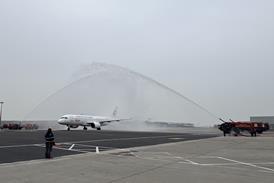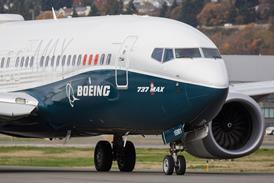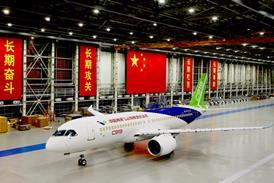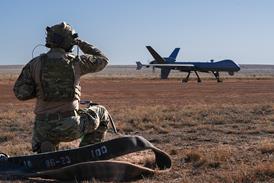It is early spring in Vienna. It has been a cold and snowy winter, but now the first buds are appearing. Mario Rehulka and Herbert Bammer sit back in their chairs. They can afford to relax. In the six years since they were appointed joint presidents of Austrian Airlines, they have turned a loss-making regional carrier into a profitable international player. The marriage, it seems, has been successful.
Rehulka and Bammer took the reins of Austrian in 1993, just when the airline's fortunes bottomed and losses peaked. The pair cut costs and jobs, brought their Austrian rivals to heel and entered a world alliance. They found a niche market - and made a profit.
The turnaround began in that first year with a severe cost-cutting programme. Eventually, more than 20% of the airline's workforce were to lose their jobs. Austrian's progress stepped up a gear in 1997, when it bought a 36% share in its bitter rival, Lauda Air, and in 1998, when it took full control of regional carrier Tyrolean to form the Austrian Airlines Aviation Group.
The détente with Lauda was vital. Their rivalry was taking chunks out of margins as both carriers competed for the same passengers on European routes. After the equity stake was sold, Lauda dropped its German routes but bought into the Austrian network routes to Asia and Australia. Tyrolean was, and still is, the predominant domestic and regional carrier. It was also named regional airline of the year in 1998 by the European Regions Airlines Association.
Severe cost cutting
Austrian's turnaround was helped by external factors too. Vienna airport, the carrier's main hub, was rebuilt and is now one of the most efficient transfer hubs in Europe. Best of all, an economically developing eastern Europe has given Austrian a natural expansion market. This also makes the airline attractive to a global alliance.
But it was the cutting back of the dead wood in 1993 and 1994 that now allows Bammer and Rehulka to relax and enjoy the early spring sunshine. More than 900 people lost their jobs at that time. The cutbacks were ruthless - even senior management were forced to reapply for their positions. But something drastic had to be done. Austrian's losses in 1993 amounted to Sch730 million ($58 million).
"The workforce thought the losses were a short-term crisis caused by the Gulf War," says Bammer. "They didn't realise that the whole environment had changed and did not believe the losses could become permanent."
He says it was difficult to explain to staff that the airline was in difficulties after they had been told for so long by the previous management that Austrian was an unsinkable ship. "Turning the minds of Austrian employees was by far the hardest job we had to do," he says of his six years in charge - but it was a struggle that produced results. Distribution costs were slashed to 21.8% and profits for 1998 are expected to be around Sch925m.
"We have done a lot," says Bammer, "but we still have a lot more to do."
Joint decision making
Working as joint chief executive officers has helped Bammer and Rehulka make the tough decisions. The two men worked together in the airline's marketing side before coming together as chief executives. Bammer says this made their task easier because it was not like pitching a marketing man in with a pilot, or an engineer with a salesman. Bammer joined the airline in 1965, Rehulka in 1966. "So we have 67 years of experience between us," says Rehulka.
"We do not have to decide difficult questions alone," adds Bammer. "It means that you always have someone to consult and it is good to be able to cross-check with another person. We are used to working like this and from the first day onwards, we had no problem."
Talking to the pair, you see what they mean - these are two men who are definitely on the same wavelength. They address questions politely in turn. Nothing is added by one, nothing disputed by the other. No glances of reassurance are needed by either.
Bammer's English is fractionally better than Rehulka's - the result of a couple of years at a US university. But conversation - an Austrian art form developed only after hundreds of man-hours spent in Vienna's coffee houses - flows.
"The only problem with having two chief executives is that sometimes we get confused about whose turn it is to take the chair," says Rehulka.
"This is an uneven week, so it is my turn," offers Bammer.
Rehulka continues: "This means that we can both welcome you here today, for example, but only one of us can say it."
"We've never disagreed," adds Rehulka as he lights yet another cigarette with his gold lighter. "We have the same business strategy and it was quite easy to agree even on how to reorganise in 1993. There was never any disagreement."
So is working together anything like being married? "No, not really," says Bammer, playing with his tie. "Marriage is much more difficult."
Alliance strategy
Austrian Airlines is still state-owned, a position that will change before the end of June when the Austrian state holding company sells eight million of its shares. But according to Rehulka, despite its majority stake, the state has never interfered with strategy. This has allowed Austrian to develop its core strategy of consolidating the domestic market and expanding its international one.
A pivotal part of this strategy has been its alliance with Delta and membership of the Qualiflyer group. Doubts remain in the industry about the future of these groupings, particularly as Delta is keeping its hand close to its chest and Air France is now available for partnership.
But with its route network in eastern Europe developing fast, Austrian itself has become attractive to a global grouping. That is why Rehulka and Bammer are confident of keeping the alliance with Delta going. "There is no doubt there is a future," says Rehulka.
However, if an alliance between Delta Airlines and Air France goes ahead, it will throw into balance the future of both the Atlantic Alliance and the Qualiflyer group. Swiss Air and Air France overlap many times on routes, so if the Delta-backed Atlantic Alliance is absorb a carrier the size of Air France, concessions will have to be made. And if Delta does team up with Air France, what will happen to Austrian's links with the North American carrier?
"A Delta-Air France deal would not be a problem for us because we have a different geographical position," says Bammer, adding that Leo Mullin, Delta's CEO, has confirmed to him that he will continue to co-operate with Austrian.
"We understand that Delta would like to have two partners in Europe," says Rehulka, ""but we are not threatened by this." He adds that the anti-trust immunity enjoyed by the Atlantic Alliance is one of the strongest reasons for Delta staying with its partners. Also, the multi-hub system of the Qualiflyer/Atlantic Alliance uses Zürich, Brussels and Vienna rather than concentrating on just one hub, as the other alliances do. "This means that the individual carrier can expand locally to whatever the market need is," says Rehulka. That suits Austrian, but the question remains: does it suit Delta?
No matter what happens, Austrian will have some breathing space. Air France still has an agreement with Continental and the absence of an open skies agreement between the USA and France could put the brakes on a little more. Without this, any co-operation between Delta and Air France could only be on the basis of a codeshare and block space agreements.
Hans Fruhmann, aviation analyst at CAIB Investment Bank in Vienna, says the worst-case scenario for Austrian would be Delta leaving the Atlantic Alliance, but he points out that had this happened a few years ago, it would have been a serious blow for Austrian. Not so now.
"Austrian has managed to get its own profile, its own unique selling position, which now makes it an attractive alliance partner for Delta," says Fruhmann.
Even though Austrian is in a much stronger bargaining position now, it probably has done it no harm having Air France in the picture, he adds. "Delta talking to Air France is forcing Austrian to establish its own strategy. In the past they always seemed to go with Swiss Air. Now they are being forced to look out for themselves."
Eastern Europe
According to Fruhmann, the most attractive feature of Austrian's portfolio is its route network in eastern Europe. In the latest International Air Transport Association (IATA) forecasts, eastern Europe still has growth rates of 6.9% over the next three years despite the financial collapse of its neighbour, Russia.
Here, Austrian's strategy is to add, route by route, cities that are so far under-served. Eastern Europe or, more critically, central Asia, offers Austrian enormous potential, says Fruhmann, but for the moment it provides just 13% of Austrian's revenue and 5% of its passenger kilometres. Western Europe still provides the bulk of sales and Austrian says its central strategy remains the development of its long-haul services to North America, Australia and north-east Asia.
That said, Austrian is often the only western European carrier to serve second or third cities in the countries of the former Soviet Union. "There are now many more countries [in central Asia] and they allow more flights," says Rehulka of central Asia's potential. "In the days of the Soviet Union, for example, you could fly to Moscow and that was it. Now there are plenty of places to go to."
In the past year, Austrian has added such cities as Kharkiv, Tbilisi and Astana to its network. "No one knows where Astana is, but we are flying there," jokes Rehulka. "And as far as risk is concerned, unlike other industries, you don't have to keep producing something. If we find out we are losing money, then we simply stop flying."
Austrian can employ its fleet flexibility according to demand, using relatively small aircraft for its services into eastern Europe and out-playing carriers from London because they have to use larger aircraft to make the route economical. Austrian's fleet is also one of the youngest in the world, averaging just five years. CAIB's Fruhmann believes this combination of fleet flexibility and youth sets up Austrian well to cope with any cyclical downturn.
Bammer sees it that way too. "If we run into problems, we could use our flexibility. You have to view eastern Europe and central Asia not as one region but as separate markets. The former Yugoslavia is a different market to those in the former Soviet Union."
The strategy is not risk-free, but Bammer insists that Austrian is well placed to cope. "Two daily flights to New York are riskier than maybe three to Tashkent. If the flights to Tashkent lose money, then we just withdraw it. We just have to make sure we do not have too much exposure on new routes.
"We can also make a loss. And if you do make a loss, you have to make sure the decision process is in place to pull out quickly. We can do that."
That's where Austrian has another edge over its rivals. It is still a relatively small player and the restructuring brought a flat organisation in which decisions can be taken easily. "As fast as we can decide to start a route, we can stop it too," says Bammer.
With Asia's financial contagion spreading to Russia last August, most local carriers in the region saw load factors drop in the second half of 1998.
Austrian says it experienced a fairly recognisable flight to quality, maintaining its load factors at the expense of local carriers. "We have found a big niche and we are good there," says Rehulka. "That's why the customers have stayed."
and central Asia
It is the alliance with Delta that could prove the lynchpin for Austrian's success in central Asia. The crude idea is for US-based cotton growers, oil producers and Coca Cola executives to be shipped into Vienna by Delta and on to Turkmenistan, Kazakhstan and Uzbekistan by Austrian.
One of the reasons it can market this idea is the short transfer time at Vienna airport - just 25 minutes, less than for any of its relevant rivals. The airport is still well below capacity but is also one of the most expensive airports in Europe. This has kept the opposition away because to date, no low-cost carriers operate to Vienna despite British Airways' go talking of starting a Stansted-Vienna route.
In the future, Austrian says it could use Tyrolean as its counter to the no frills airlines should they ever make an appearance. It has a good cost structure, says Bammer, and could still generate profits, but it is a plan that is still very much at the back of the filing cabinet.
For the next few years, says CAIB's Fuhmann, Austrian will concentratie on consolidating its position rather than recklessly expanding further. Load factors rose to 69% in the first half-year and the future looks bright.
It has stolen a march on its rivals by expanding into central Asia and is now well placed to take advantage of the opening-up of eastern Europe. No other airline enjoys such geography, efficient hub system and feeding alliance system together in one package. It is still the early days of spring in Austria, but if the weather stays calm, it won't be just the flowers that are blooming in Vienna.
Source: Airline Business













































